The Legend of Zelda Manga Part 2: Ocarina of Time’s Ending
Posted on April 10 2009 by Nathanial Rumphol-Janc
 Note: For those reading for the first time, please direct yourselves to Part 1 of this ongoing series to get the full story on the Legend of Zelda Manga. This article will relate and reference back to Part 1
Note: For those reading for the first time, please direct yourselves to Part 1 of this ongoing series to get the full story on the Legend of Zelda Manga. This article will relate and reference back to Part 1
. This article will contain spoilers for both the Manga and the game.
The Legend of Zelda Manga Part 2 was released on November 25, 2008 in the U.S. To my surprise, it was substantially easier to find than Part 1. Barnes and Noble had a whopping three copies this time, with one additional copy of Part 1. Granted, I bought my copy of Part 2 a week after the release, but to see so few copies stocked makes me think that the Manga isn’t expected to sell well. Despite their skepticism, this has no affects on the material within the Manga. Should this skepticism continue the chances of more localized manga may cease.
In any case, let’s start from the very beginning, the cover. What is the deal with Link’s hat? I understand his hat length varies from game to game, but this cover is ridiculous.
 Perhaps their intention was to show a goofy child friendly image for a younger market, but the artistic style of the rest of the Manga shares few similarities, so the cover can be misleading. Part 1 had a pretty childish cover, but the picture depicted a younger Link, which more appropriately fit the style of the younger Link in Part 1.
Perhaps their intention was to show a goofy child friendly image for a younger market, but the artistic style of the rest of the Manga shares few similarities, so the cover can be misleading. Part 1 had a pretty childish cover, but the picture depicted a younger Link, which more appropriately fit the style of the younger Link in Part 1.
With adult Link, the artistic style is much more serious, which just so happens to be my favorite part of the Manga series. Since the cover is the only colored image in the entire Manga, it is a real shame the publisher couldn’t display something that better reflects the artistic style of the rest of the Manga. Please, like all books, don’t judge this book by its cover
The second page of the Manga, still inaccurately insists Ocarina of Time was released in 1996, rather than the widely known year of 1998.
 It’s the exact same page from Part 1 so clearly the editor still isn’t doing his job, despite the uproar from the community after the initial release. To be honest, this isn’t a huge surprise, but it would be nice if the editor would start fact checking before releasing any more volumes.
It’s the exact same page from Part 1 so clearly the editor still isn’t doing his job, despite the uproar from the community after the initial release. To be honest, this isn’t a huge surprise, but it would be nice if the editor would start fact checking before releasing any more volumes.
This time around in the author’s notes, Akira Himekawa refers to playing Smash Bros. Himekawa explains how when playing the game with all four Links, Blue Link is apparently the most cruel, ruthless and brutal. Purple Link is the next strongest yet calm. Red Link is somehow passionate, and Green Link is just green. My guess is, Himekawa liked to set four Links to computers for an even dual, otherwise play styles would be based on the player, but who really knows what Himekawa means? Now I am unsure which Super Smash Bros. game Himekawa was playing, but I am certain that there is no Purple Link in any Super Smash Bros. game. The original Super Smash Bros. had Green, Red, Blue, and White, which I assume is the game Himekawa was talking about, since that was the only game released near the time of the manga’s Japanese release. Just to be sure, Super Smash Bros. Melee has a Green, Red, Blue, White and Black tunic, while Super Smash Bros. Brawl has Green, Red, Blue, and the unique Shadow Link. None of the three games have a Purple Link. Maybe one of the Japanese versions of Super Smash Bros. had a Purple Link, but that is very doubtful.
The actual story starts inside Ganon’s Castle. Ingo is apologizing to Ganondorf after losing Epona to Link in Part 1. As punishment, Twinrova brainwash Ingo in order to betray the Hero of Time. None of this ever happens in the game, and this brainwashing theme reoccurs throughout the Manga, which is really unnecessary, considering how eager he was to run the ranch in the game. Ganondorf sends Ingo to defeat the Hero of Time, and asks Sheik to go with him. Then Ganondorf asks Sheik why he serves him, in regards to the Sheikah once serving the Royal Family. Sheik briefly explains that the tribe had no leader until Ganondorf came, then leaves.
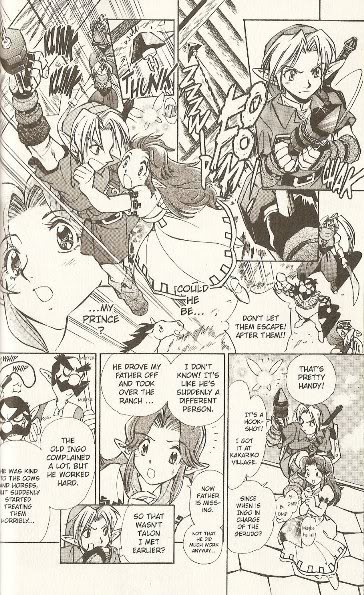
In the next scene, Link enters the story riding Epona when he finds a tear filled Talon wandering Hyrule field. Talon explains that Ganondorf has taken Malon for not giving up Epona. With little more explanation, Link races to Lon Lon Ranch. The recently brainwashed Ingo has Malon tied up and starts beating the horses, all in order to lure the Hero of Time. A bit stereotypical, but it’s reasonable. Malon starts pitying herself by reflecting on her life, and wishing for a Prince on a White Horse to come in and save her. At this appropriate moment, Link falls through the ceiling. It takes a moment for Malon to recognize Link, due to the seven year difference. Link cuts her free and tries to leave with her, but Malon refuses insisting that her Prince will come and save her. This scene is filled with so much irony especially considering the amount of suggestive love stories we saw from Part 1.
Suddenly, Ingo appears with a party of Gerudo ready to fight Link. Moments after engaging in combat, Malon notices how grown up Link has become gradually deciding Link just might be her prince. Link pulls out a hook-shot and propels to the roof, then points out that he got the device in Kakariko Village. Now why couldn’t they have briefly explained that in Part 1? The writers could have easily had Impa or someone in Kakariko village hand the device to Link. This kind of writing is the result of poor planning and comes off looking lazy. Not a good way to start off chapter 1.
Sheik finds Link on the rooftop to say that Twinrova has brainwashed Ingo. He instructs Link to go to the Haunted Wasteland to search for Zelda. Sheik then quickly leaves the roof conveniently before the Gerudo catch up. After hearing about Link’s search for Zelda, Malon quickly forgets the idea of romancing with Link. Malon, in fact, manages to find a pitchfork and assists Link in battle with the Gerudo. Once the Gerudo are defeated, Ingo holds the two up with his crossbow; I didn’t know that technology existed in Ocarina of Time.
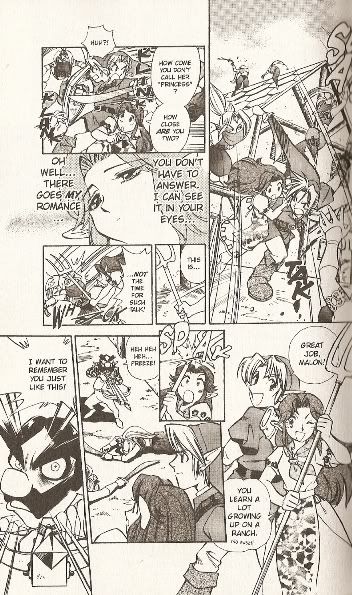
Link disarms Ingo with the hook-shot and strikes him in the ear with his sword, which just so happens to have a jewel that was the source of the Twinrova spell. Once again, the brainwashing thing is a bit cheesy, and this didn’t make it any better.
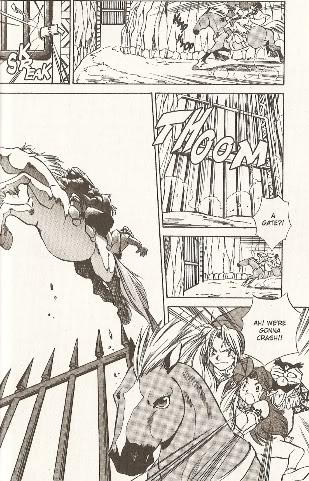 The Gerudo get reinforcements, and Link hops on Epona with Malon and Ingo to make a run for the entrance, but of course, the gate slams shut. Epona, unhindered by the obstacle, leaps over the gate leaving the Gerudo momentarily trapped inside, ceasing their pursuit.
The Gerudo get reinforcements, and Link hops on Epona with Malon and Ingo to make a run for the entrance, but of course, the gate slams shut. Epona, unhindered by the obstacle, leaps over the gate leaving the Gerudo momentarily trapped inside, ceasing their pursuit.
Saying his goodbyes to Malon, Link travels to the Haunted Wasteland. Despite my complaints, this chapter was really an action packed start. Watching Lon Lon Ranch turn into such an epic battle ground was quite refreshing. Some of the contexts of the battle were cheesy, but forgivable. One thing to point out is how absolutely none of this takes place in the game, but it is understandable to see the writers strive for original content, rather than regurgitating what we all already know. Besides, it is kind of fun to see one of the more peaceful areas of the game turn into such a battleground.
Now here is where things get pretty confusing. The end of Chapter 1 shows Link in a desert environment, with an image of Zelda stretching across the landscape, hinting that Link has already entered the Haunted Wasteland. In Chapter 2, the second panel shows Link in the Water Temple with Ruto.
Ruto still uses the annoying Zora at the end of every sentence, which was discussed in Part 1. The temple formula from Part 1 stays standard, meaning Link and Ruto skip straight to the boss battle, omitting the entire temple. Morpha grabs Link, and Ruto shouts at the water monster to stop. This is really interesting, because it suggests that Ruto was acquainted with Morpha, hinting that Morpha was not always a just an evil temple boss.
 Morpha traps Ruto in a bubble, which seemed really unnecessary since the battle is so short. Link hook-shots the core once, defeating Morpha in a single hit, without any contact with the Master Sword. Ruto is freed and awakens as a Sage. She makes a passing reference to Link as her fiancé, but fortunately insists that she cannot marry due to her duties as a Sage, and that is the end of the temple. This particular temple seemed far more neglected than the temples in Part 1, which is especially disappointing since it is the only temple in the Manga that tries to hold true to the formula. The boss battle with Morpha lasts less than 2 pages, with the total temple taking only 4, which is far too short. The Water Temple is legendary for its difficulty, yet the writers turn it into a joke, rather than remind us of the challenge.
Morpha traps Ruto in a bubble, which seemed really unnecessary since the battle is so short. Link hook-shots the core once, defeating Morpha in a single hit, without any contact with the Master Sword. Ruto is freed and awakens as a Sage. She makes a passing reference to Link as her fiancé, but fortunately insists that she cannot marry due to her duties as a Sage, and that is the end of the temple. This particular temple seemed far more neglected than the temples in Part 1, which is especially disappointing since it is the only temple in the Manga that tries to hold true to the formula. The boss battle with Morpha lasts less than 2 pages, with the total temple taking only 4, which is far too short. The Water Temple is legendary for its difficulty, yet the writers turn it into a joke, rather than remind us of the challenge.
 Link leaves the temple and travels through the Wasteland, or desert, until he arrives at a village. The town, similar to Castle Town from Part 1, is large and well populated. It doesn’t appear to be the Gerudo Valley fortress, since both men and women are present. The town has lots of people and open shops all ready for trade.
Link leaves the temple and travels through the Wasteland, or desert, until he arrives at a village. The town, similar to Castle Town from Part 1, is large and well populated. It doesn’t appear to be the Gerudo Valley fortress, since both men and women are present. The town has lots of people and open shops all ready for trade.
Link arrives wearing a very nice looking cloak. Not only does it make more sense to have while traveling the desert, but it is especially smart to look discrete while traveling through possible enemy territory. Link stops at an open shop to purchase food, water, and a bundle of arrows, when the disguised Twinrova gain his attention.
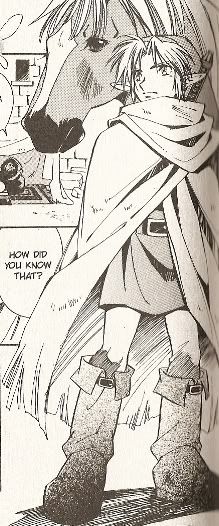
They tell Link to travel to the Spirit Temple to find his destiny. Link accepts their advice and leaves. Sheik arrives near Twinrova who order him to follow Link. They for some reason sense hesitation and suggest that Sheik is secretly helping the Hero of Time. Sheik denies their claim, but they insist that Sheik must go prove himself. Once Sheik departs, Twinrova summon Nabooru to assist Sheik and determine if he is indeed a traitor.
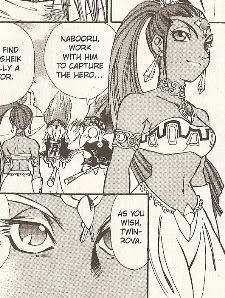
While none of these events take place in the game, which is already well established by now, it is important to take note that Nabooru is following orders from Twinrova. In the game, Nabooru discretely leads a personal rebellion against Ganondorf, until Twinrova discover her betrayal and brainwash her into an Iron Knuckle. In the Manga, this does not seem to be the exact same case.
In order to further distract Link, Twinrova summon a sand storm to hinder his progress. Before getting swallowed up by the sand, Sheik pulls Link out. Unfortunately Link loses his cloak to the sand. Sheik offers to guide Link through the desert, and he promptly accepts. While traveling, the two carry on a mild conversation. At one point, Link asks about the eye on Sheik’s outfit. He explains that the eye was originally the symbol of the Sheikah, but they added a tear when the Royal family betrayed them. Link asks if Sheik still has a grudge against the Royal Family, but Sheik says no.

Link explains his own story, being raised as a Kokiri, but finding out he was actually Hylian and a destined hero. He explains the confusion behind losing seven years of his life. To him, he just recently left Zelda, but to her, he’s been gone for seven years. Link then says he is curious how the years have changed her, and feels uneasy to see her again. Unsure why he is saying so much, Sheik tries to comfort him by saying that it’s hard to be a hero.
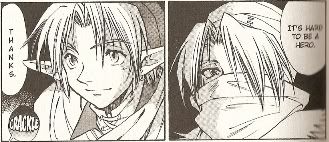
The two set up camp and go to sleep for the night, but Link wakes up to see the Great Deku Tree. When he approaches the tree, it vanishes and an army of Stalfos appears. Link tries to fight off the army, when a puzzled Sheik wakes up and asks Link what he is doing. Sheik explains that in the Haunted Wasteland, phantoms try to deceive unwary travelers, and confirms that there is nothing around. Various images from his past, Part 1, continue to taunt Link throughout the night.

In the morning, a party of Gerudo surround Link and Sheik. While Link is distracted, Sheik strikes Link in the back of the head, rendering him unconscious. Link wakes up in a prison cell, unarmed.
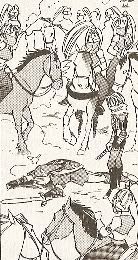
Nabooru arrives with a sword and forces Link to get up. Secretly releasing himself from his chains, Link snatches the sword from Nabooru. She steps back to the wall and grabs another mounted sword. I’m not sure why the prison had an extra sword inside it.

Granted, the Gerudo thought Link was chained up, but leaving sharp weapons in the same room as a prisoner seems like they want prisoners to escape. This leaves me really wondering why Link didn’t just grab the extra sword and escape earlier, since he had already released himself from his chains. The Gerudo Valley prison from the game had pretty bad security as well though, since they didn’t even bother to disarm their prisoners. However, in the game, the Gerudo didn’t really know Link was the Hero of Time, especially since they later grant him membership. In the Manga, since it is well established with them who Link is, I would think they would have taken every precaution when dealing with the Hero of Time.
After a brief sword fight with Nabooru, Link lands a critical strike on the Jewel on Nabooru’s forehead. This knocks her unconscious, allowing Link to flee. When she comes to, she shows signs of being brainwashed as well. Now, Nabooru does get brainwashed in the game, and turned into an Iron Knuckle, which worked fine. The Manga, on the other hand, takes it a bit far. Having Nabooru brainwashed in her present form is far less interesting than turning her into an axe wielding mini-boss. What happens next in the manga still bewilders me. After Nabooru is rendered unconscious, there is a small panel of the hook-shot. The text in this panel says nothing more than “A Hook-Shot?!” What on earth happens here? Did Link find it on Nabooru, and if so, why was that the only thing on her?
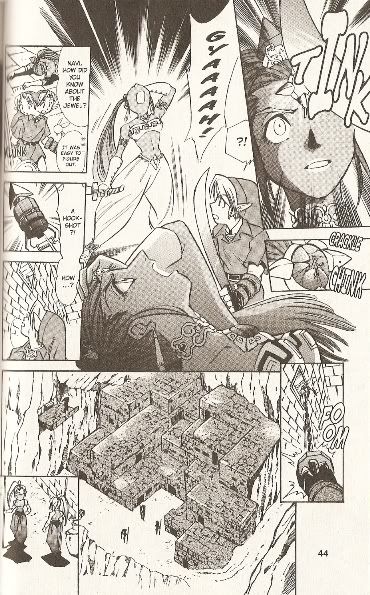
Does this mean the rest of his equipment is gone? We know Link lost his shield and sword since they are visibly gone and he had to resort to using Nabooru’s sword, but what about his bow and arrows? If Nabooru didn’t have the hook-shot, then why did Link react to finding the hook-shot in his own inventory? Plus, if this was indeed the case, Link could have escaped the chains, grabbed the sword from the wall, and hook-shot himself out the window before Nabooru had a chance to show up. The writers brushed passed this minor detail probably for pacing, but they just end up confusing the reader.
Link escapes from the window but quickly gains the attention of the Gerudo guards who pursue him, which is pretty ironic since the game wouldn’t let the player run once he is spotted. Once outside, Link gets surrounded and Sheik blocks his path, holding the Master Sword and Link’s shield. Sheik throws the weapons to Link, and draws his dagger as if wanting to duel.
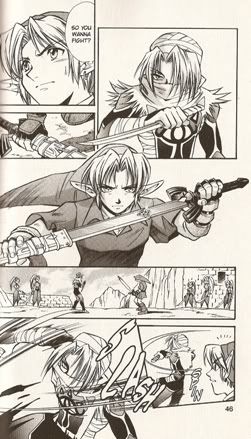
Link picks up his equipment and readies for battle, when Sheik turns and strikes Twinrova behind her. The two make a dash for the exit, in which Sheik apologizes for hitting Link earlier. Realizing Sheik’s betrayal, Twinrova pursue the two and deliver a near fatal magic attack to Sheik.
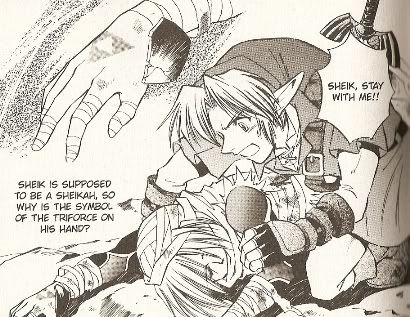
Trying to help the unconscious Sheik up, Link notices the crest on Sheik’s hand. Still fighting off Gerudo, Link struggles to escape with Sheik. To his luck, Nabooru steps in to fend off the attacking Gerudo, giving Link the opportunity to escape. Leaving the village, Link reaches Epona, but gains the attention of a number of Moblins and Lizalfos. Now with his hands free from carrying Sheik, Link shoots down their pursuers with arrows.
While this scene was full of action and very nicely drawn, it suffered quite a bit from bad planning. The prison room was pretty hard to swallow, despite what happens in the game, but mostly having the pre-brainwashed Nabooru was completely unnecessary. For instance, what if Nabooru had faked her allegiance to Ganondorf, like Sheik? She could have snuck into a very well guarded prison, smuggled in Link’s equipment, revealing that she secretly does not follow Ganondorf and wants to see him fall as much as he does. Once outside, Link could have confronted Sheik who attacks the surrounding Gerudo like before. After Sheik gets wounded, Nabooru could still step in and help Link escape revealing her betrayal to Twinrova. This version gets the same point across and gives a perfectly good explanation of Link’s escape, whereas what the writers used was tacky and poorly planned. The otherwise eventful battle gets overshadowed by bad writing.
In the desert, Link finds some temple ruins to take Sheik inside so that he can address Sheik’s wounds. Sheik’s hair and face gradually becomes unraveled from the cloth. After getting a good look at Sheik, Link becomes a bit flustered; he still thinks Sheik is a guy after all. He leaves to go search for water. While Link is gone, Sheik regains consciousness and calls out for Impa. Link steps in to see a very flustered Sheik. The Triforce lights up on Sheik’s hand, and Zelda reveals her identity to Link.
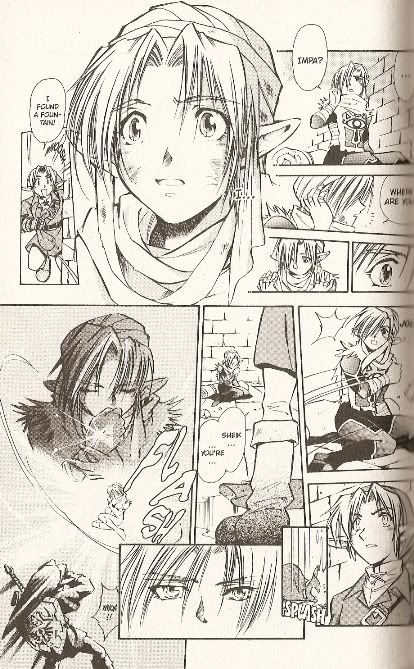
Zelda apologizes for deceiving him, when Twinrova arrive abruptly. Twinrova begin to hurl their magic at the two chasing them deeper into the temple ruins. Unsure how to fight back, Zelda mentions that the temple once had a shield that can reflect magic. They frantically search, until they are cornered by Twinrova. With a stroke of luck, Nabooru arrives wielding the shield quickly passing it off to Link. He reflects the witches’ magic back on themselves to defeat them.
Now at this point, it is pretty relevant that Part 2 could have less to do with the game. Sheik doesn’t reveal her identity until after all the other sages are awakened. In fact, pretty much the entire story of Sheik is very original from the manga. The supposed Spirit Temple served as a chase scene more than anything else, as Link and Zelda fled from Twinrova. The two don’t even unite to their second form. It is really a shame that the writers couldn’t have tried a little harder with this temple, especially since it was a bit more unique in the game, requiring the player to go back in time, in order to complete it.
Outside the temple, Link thanks Nabooru, who reveals that she had stolen the shield from the temple awhile ago. This was a very nice touch, since the Gerudo thieves don’t ever seem to do any stealing in any of the games. Zelda went on to explain what had happened to her seven years ago.
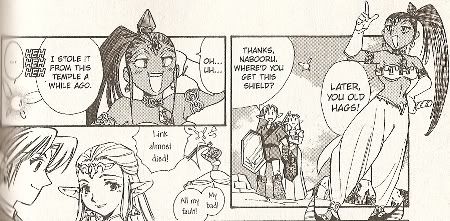
While on the run with Impa, she had decided to become a boy, disguising herself as one of Ganondorf’s minions until Link returned. Impa agreed and decided to disguise Zelda as a Sheikah descendant. Then Impa placed a spell on Zelda saying she will place Zelda’
s consciousness asleep. Not too sure what is meant by this. At first, it seems like Impa places Zelda under a spell so that Sheik has no idea who he really is.
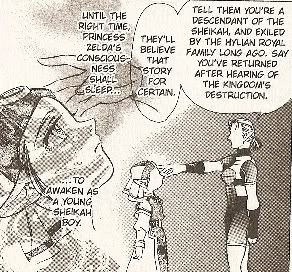
This theory makes it kind of awkward to explain why Sheik helped Link all along had he not known he was actually Zelda. Not to mention, he’d probably be really confused every time he had to go to the bathroom. If we assume Sheik knew he was Zelda, his motives are founded by the intentions of Zelda, but then this panel makes little to no sense. Hard to say how we should take this, but based on some of the other obvious plot holes, it’s just easier to ignore the thing and assume nothing of it.
Getting a bit teary eyed, Zelda tells Link she was really glad to fight by his side. He responds with how he missed her and the two experience a brief happy moment together. While this scene may get a bit too personal between the two characters, it’s hard not to expect it especially after seeing all the foreshadowing from Part 1. The earth starts to shake and a seal surrounds Zelda.
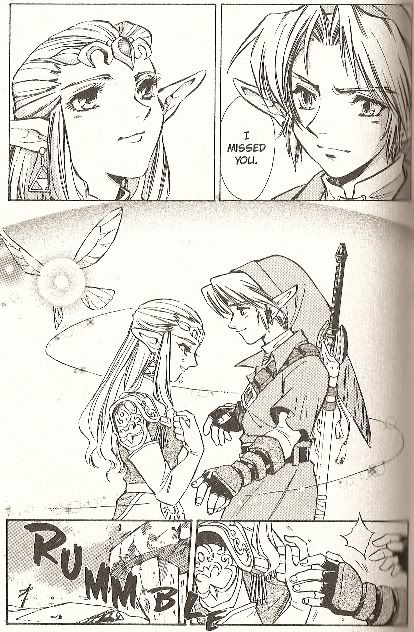
Ganondorf’s booming voice sounds declaring his disgust over Zelda deceiving him for the past seven years. He gives Link a formal invitation to his castle and leaves. This is probably my favorite scene from the game, so some of the key differences in this part were very noticeable. In the game, Sheik meets Link in the Temple of Time after he awakens all the necessary Sages. Sheik then reveals his true identity as Princess Zelda. After explaining herself, Ganondorf forms a seal around her and says:
“Princess Zelda…you foolish traitor! I commend you for avoiding my pursuit for seven long years.
But you let your guard down… I knew you would appear if I let this kid wander around!
My only mistake was to slightly underestimate the power of this kid
No… It was not the kid’s power I misjudged, it was the power of Triforce of Courage.”
This reveals so much back story to what was going on while Link was wandering around Hyrule. Not only did Ganondorf unintentionally gain access to the Sacred Realm by Link’s actions, but he intentionally held back his forces to allow Link to survive until Zelda revealed herself. Ganondorf obviously couldn’t locate Zelda on his own, since he couldn’t do it after seven years, so he used Link as bait to lure Zelda out of hiding. There is nothing like the perfect evil plan to make the player feel absolutely used. To those naysayers that complain that Ocarina of Time is way too easy, I argue that this was exactly Ganondorf’s point. If he had sent his full armies at Link all at once, Link would have potentially died ending any chance he had at finding Zelda.
The Manga takes away some of the magic of this scene in the game by wording it the way they did. Ganondorf showed no sign of the ingenious plan to lure Zelda out of hiding, rather all this time he literally did nothing but sit on his throne. Not only that, but due to Sheik’s new subplot, he hired the very person he hardly bothered to look for. This definitely takes away some of the charm behind the title King of Evil, and makes his limited resources used against Link all the more pathetic. It is interesting to note that in the game, Ganondorf does call Zelda a traitor, hinting at some of the possibilities Sheik may have had behind the scenes.
Link makes it back to Gerudo Valley, and camps out with Nabooru and a large group of Gerudo. This caught me a bit off guard because a moment ago the Gerudo were still the enemy.
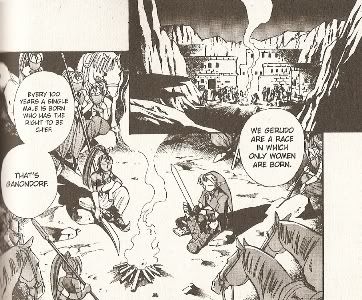
Nabooru is their unofficial leader, aside from Ganondorf, so perhaps after Nabooru was un-brainwashed by Link, the other Gerudo followed suit. This of course is contradictory to when the Gerudo attack Nabooru while she helped Link escape earlier, but then again Twinrova could have brainwashed all the Gerudo. Nabooru does make a reference to “waking up” the other Gerudo, which could mean she wanted to break the Jewel on every Gerudo’s head, which is a pretty daunting task for one person. However, after the Jewel was damaged on Nabooru, the cracked detail remained several pages later, but the surrounding Gerudo do not have this same detail. So this hints that the Gerudo were not brainwashed and are just fickle about whose side they’re on. Having the Gerudo in this scene is confusing and should have been left out, especially since they serve no purpose other than background.
Nabooru fills Link in on some of the history behind the Gerudo. She explains that the Gerudo are a women only tribe, but every hundred years a male is born to become their leader, which is Ganondorf. However, Link only wants to talk about Zelda, as usual. He comments that he barely got to touch her before Ganondorf stole her away.

Nabooru points out how tightly he was holding her when they escaped the fortress, but he decided that didn’t count since he didn’t know who Sheik really was at the time. This whole scene gets a tad bit too personal for me. If Link had said he barely got to see her, then that would be reasonable as a close friend who genuinely cares for the other person, but wanting to touch her makes me question his intentions. Throughout the chase scene inside the Spirit Temple, Zelda is hanging all over Link, so it’s not like he’s disappointed he didn’t get a nice firm handshake out of her. I just don’t know. This reference just seems borderline sexual, which is a bit steep for Nintendo.

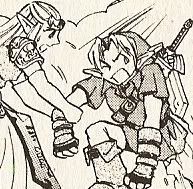
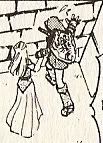
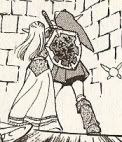
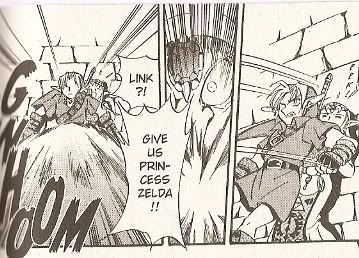
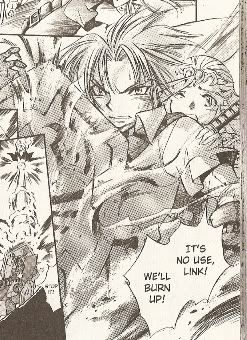
Link gets up to go to Ganon’s Castle, and Nabooru decides to go along too. When they arrive at the castle, they briefly fight off a few Redeads. Rauru, the Sage of Light, chimes in and awakens Nabooru as the Sage of Spirit. First of all, it is usually traditional to awaken the sages at the end of a temple. Second, if Rauru can simply awaken a sage at his own discretion, then why didn’t he do so right from the start rather than forcing Link to do the run around? This was the writer’s way of keeping Nabooru in the plot longer than necessary, and the result hinders the purpose behind Link’s destiny. Nabooru acts a bit disappointed that she couldn’t fight by Link’s side, which would have been interesting actually, but she will instead continue to help him as a sage. The reunited sages create a bridge to Ganon’s Castle and Link continues inside. Now in the game, when Link enters the castle, there are 6 mini-temples he must complete before fighting Ganondorf, but in the Manga, Link has to kill 3 bats on his way up the stairs, which somehow seems less epic. No offense, but Ganondorf could try a little harder on the security.

Link enters a big room at the top of the stairs with Ganondorf playing the organ, and Zelda located high above him. Ganondorf gives a similar speech as in the game about the Triforce, and the two quickly start fighting. After a few magic based attacks, Ganondorf pulls out his sword. A good sword fight was something I always felt was missing from the game, but in this case, I was a bit distracted by his sword. The sword is rather long, and very skinny, which looks very laughable when running up against the Master Sword. While in the game, Ganondorf’s sword makes no appearance, Super Smash Bros. Melee along with the very misleading GameCube Tech Demo, display a much wider sword with a curved tip.

I always liked this design, and it is disappointing that they couldn’t have used something similar instead, but perhaps that design hadn’t existed yet, since the two existing sources hadn’t been made at the time of the original Japanese release.
After a few clashes of the sword, Ganondorf seems to lose confidence and uses magic to conduct electricity through the connecting swords giving Link a powerful shock. Stunned by the electric shock, Link calls Ganondorf a coward. Ganondorf comments on Link’s Master Sword and its ability to banish evil, basically hinting that the sword is his disadvantage.
Ganondorf summons a large orb of dark energy and fires at Link as if to challenge the Master Sword after his shrewd comment. Link reflects it back at Ganondorf, leaping through the dark explosion after contact, and landing one swift blow to Ganondorf with the Master Sword. Ganondorf, in disbelief, collapses to the floor.
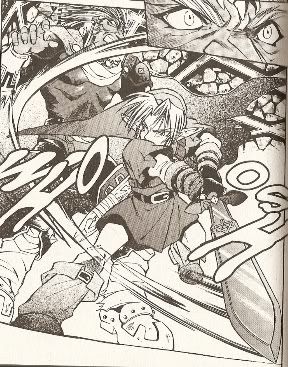
Zelda is released from the seal and the cast
le begins to crumble. The two escape the castle just moments before it collapses. Confident that the battle is over, the two hear a loud noise from the wreckage. When Link steps forward to investigate. Ganondorf rises out of the debris, and with his Triforce glowing he turns into Ganon.
Overwhelmed by the sheer might and size of the beast, Link loses grip of his sword, sending it flying in Zelda’s direction. She picks up the sword gaining Ganon’s attention, leaving Link at his back. Zelda throws the sword to Link giving him the perfect opportunity to strike Ganon’s tail. Upset by the cheap shot, Ganon redirects his attention to Link, allowing Link a strike at his head. Thoroughly wounded, Ganon begins to slow down giving Link the opportunity for a deep vertical slice from head to toe. Mortally wounded, Ganon collapses to the ground, awaiting the final blow.
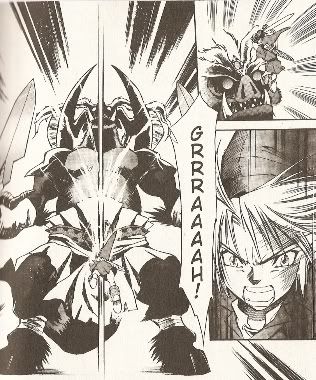
The sages open a seal and lock Ganon away in the oddly named netherworld. Earlier in the manga, back in the desert, Zelda informs Link that the sages can lock Ganondorf away in the Sacred Realm, so why they used the term netherworld here is confusing, but I assume these are supposed to be the same. While it was nice to see Link require more than one hit with a sword to kill Ganon, unlike every other boss in Part 1 and 2, the battle still lost some of its charm. Zelda took a stronger role in the battle, which was nice, but the story really missed out on the opportunity when Link loses his sword. There is nothing more intimidating than the first time facing Ganon in the game, just to lose your sword, the one piece of equipment you relied on the entire game. The writers simply did not allow enough time to capture the desperation the players felt when Ganon disarms Link of the Master Sword. As far as boss fights go, the Manga still does a pretty noble attempt at this one.
In celebration, Link begins plans for the future, explaining to Zelda how he will help rebuild Hyrule. With a very upset look on her face, she informs Link that they must part.

She explains that with the Ocarina, she will send Link back to his time, and close the gateway between them. Very upset by the news, Link argues that he did not fight because he was drawn to conflict, he fought for her. After a moment of looking at one another, Zelda reluctantly insists that heroes aren’t needed during peacetime, and that he needs to return to the forest where he will be happy. Out of respect, Link takes a knee and vows to Zelda that he will serve Hyrule and Princess Zelda no matter what time or place. He hands her the Ocarina, and she begins to play.

Now, with all the foreshadowing from Part 1 and 2, I half expected another kiss or at least an embracing hug, but surprisingly there were few physical hints of romance aside from a few upset facial expressions. Then to my surprise, as Link ascends away from Zelda, she says her good-bye, and then adds “Link… I love you.”
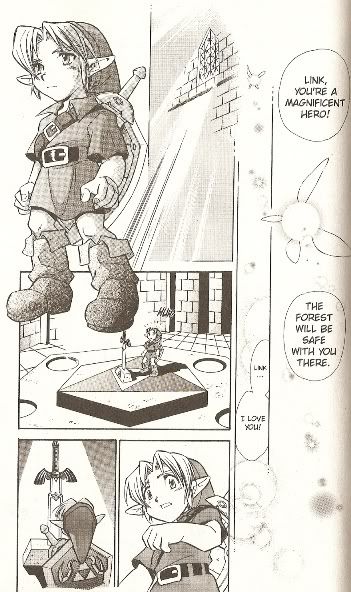
So there we have it. Part 1 and 2 had more than enough love story fan service, so ending it with the three big words is to be expected. Bad timing on Zelda’s part, but the writers were already pushing their limit with that and Nintendo probably wouldn’t allow them to go any further. While I am not the biggest fan of the Link and Zelda love story, I still felt that the Manga was respectful enough of the series not to let it get out of hand, which would be pretty easy to do.
Back seven years, in his original time, Link returns to Zelda in her garden peeping through the window. While she first displays an expression of surprise upon noticing someone’s presence, she gets a pleasant tear filled smile across her face at the sight of Link, significantly different from Link’s original acquaintance in Part 1.
In celebration of the 10th Anniversary of Ocarina of Time, the Bombers had a debate
discussing the time placement of this event from the game, but the Manga definitely suggests a strong recognition between the characters. Sorry Ben, but the Manga definitely runs in Alex’s favor.

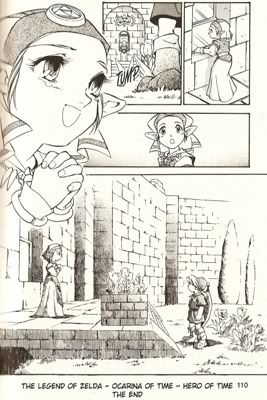
Now that the story is over, a few questions remain based on the events seen in Part 1. In my Part 1 article, I took note of Ganondorf’s unexplained obsession with the Ocarina of Time. On several occasions he expresses his desire to possess the ocarina, and I expected Part 2 to better explain these motives. To my surprise, the ocarina is hardly mentioned in Part 2. At the beginning, Link shows Malon the ocarina to remind her who he is, and at the end, Zelda uses the ocarina to send Link back to his original time. Ganondorf doesn’t make any references to it, and even when he confronts Link, he displays no desire to capture it. The Gerudo, from Part 1, also show a desire to acquire the ocarina, probably to deliver it to Ganondorf. When the Gerudo capture Link, and disarm his shield a sword, and maybe his hook-shot, they apparently don’t bother to steal away the ocarina since Link still has it in his possession at the end of the story. Having Ganondorf obsessing over the ocarina in Part 1 was irritating to me, because the writers wouldn’t explain his motivation. Part 2 was their opportunity, yet they completely forgot about it, leaving a substantial plot hole. I have tried to put up with a lot of the problems presented in this Manga, because transferring such an exploratory game into a strict story script is not easy, but when the writers harm the very integrity of the story with unnecessary plot holes, it is inexcusable.
Despite all the content covered so far, this is only halfway through the Manga. Two additional stories are added after the conclusion of Ocarina of Time. These chapters take place within the Ocarina of Time storyline both before and after Part 1 of the Manga series. These stories are additions to the story rather than a retelling of the game, so the authors get a chance to become much more creative with their own ideas. These original ideas share a surprising amount of similarities to another game, The Legend of Zelda: The Wind Waker. This also gives us a very close glimpse of what a completely original Manga story, based on the Legend of Zelda, could become. To see my analysis of these bonus chapters, and my conclusion of The Legend of Zelda Manga Part 2, please look for my next article,
The Legend of Zelda Manga Part 2: The Bonus Chapters.
Useful links



